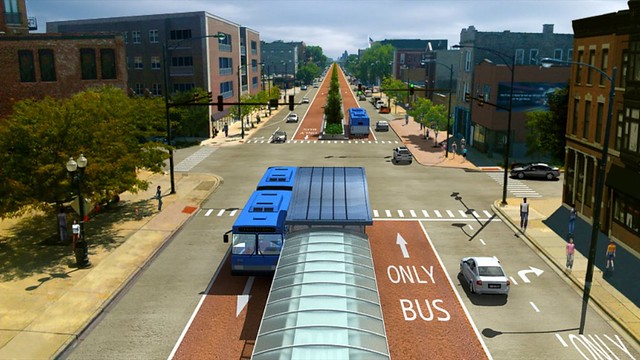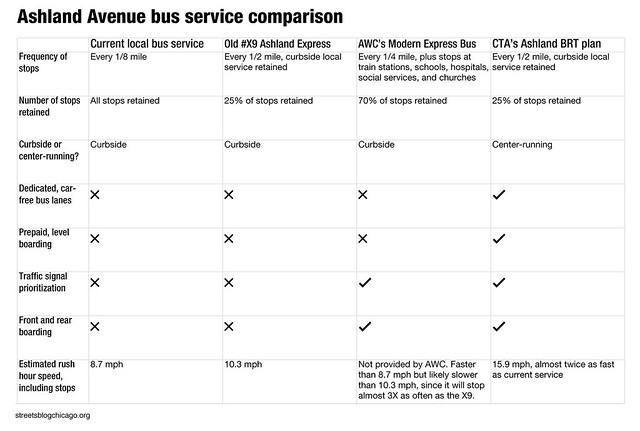The West Town Chamber of Commerce’s stated mission is to “strengthen its business community so that West Town becomes a destination for shopping, dining, professional services, nightlife and culture.” So why did the chamber's board recently make a statement of no confidence on bus rapid transit, when BRT fits right in with that goal?
The CTA’s plan to create fast, efficient transit on Ashland, which runs through the heart of the West Town community area, will be just the thing to bring shoppers to the business strips. The BRT buses will run nearly twice as fast the current service, comparable to driving speeds, which would make transit a much more attractive option for accessing retail districts, reducing the demand for car parking.
Fewer cars on Ashland and less speeding, plus wider sidewalks, more green space, and median bus stations that double as pedestrian refuge islands, will mean a much safer, more pleasant walking environment. This will increase foot traffic, provide extra space for sidewalk cafes, and create more vibrant, prosperous business districts, which is what the business organization says it wants.
However, in its October newsletter, the chamber unofficially gave BRT the thumbs-down with a long statement titled “West Town Chamber of Commerce Board of Directors’ Serious Concerns Re: CTA's Ashland Ave. Bus Rapid Transit (BRT) Proposal.” The statement claims the business organization is postponing taking an official stance on the project until they receive additional info from the CTA, but in effect they’re siding with the opposition. “The WTCC Board's current opinion… is not in support of the BRT.” Read the full statement here.
The chamber says the majority of feedback about the plan it has received from businesses and residents has been negative, but people tend to be more vocal about things they oppose than things they support. As of Monday, 1,835 people have endorsed BRT by signing an Active Transportation Alliance petition or contacting their alderman. The chamber’s territory includes walkable, bikeable, transit-friendly neighborhoods like River West, Noble Square, Ukrainian Village, East Village, Wicker Park and Humboldt Park, home to many sustainable transportation advocates. It’s likely that hundreds of these West Town residents are registered BRT supporters, and they should voice that support to the chamber by calling 312-850-9390 or emailing info[at]westtownchamber.org. If you email the WTCC, please consider cc-ing me at jgreenfield[at]streetsblog.org so I can compile the comments for a future post.
After reading the board’s anti-BRT statement, Noble Square resident and Streetsblog contributor Lindsay Banks Bayley tweeted her displeasure that her local chamber of commerce is not acting in West Town's interests:
Disappointed in @WestTownChicago for BRT thoughts. Shows they lack understanding of what makes a community great. Cars are not the future.
— Lindsay Banks Bayley (@lindsaybanks) October 2, 2013
The chamber says the opposition they’ve heard from constituents is “mainly due to the traffic problems they foresee the reduction from two to one lane traveling in each direction will cause on Ashland, and the problems that limited left turns would create redirecting traffic into residential areas.” As we’ve discussed on this site, while such concerns are common before major street reconfigurations, the experiences of other cities shows that after these projects are implemented, there are usually no major traffic headaches.
The WTCC says that before it makes its final decision it wants to see traffic impact studies on the Ashland project and economic impact reports from other cities where BRT has been implemented. The CTA will be releasing its environmental assessment later this month. This should provide information about the math behind the agency’s projections, such as their estimates that there will be roughly one-third fewer cars on Ashland, motor vehicle speeds will only be reduced by 4.9 percent, and transit mode share will increase by 46 percent.
For info about the positive economic effects of BRT in cities around the world and here at home, board members can check out the Institute for Transportation and Development Policy reports The Bus Rapid Transit Standard and The Transit-Oriented Development Standard. They’ll learn about success stories such as Cleveland’s Euclid Avenue Health Line, which spurred $5.8 billion in development, and Fordham Road in the Bronx, which saw a 73-percent increase in retail sales (compared to 23 percent borough-wide) after Select Bus Service was introduced.
Particularly troubling is the WTCC’s praise for the so-called “Modern Express Bus” counter-proposal floated by Roger Romanelli’s anti-BRT group, the Ashland-Western Coalition. “The MEB proposal… seems to make a lot more sense than the BRT,” the newsletter states. It goes on to describe MEB as “cost-effective,” although Romanelli has said he doesn’t have a cost estimate, and his proposal includes many expensive bells and whistles, such as hiring onboard “bus marshals.” Meanwhile, as the above chart illustrates, MEB would travel slower than the old 10.3 mph #X9 Ashland Express bus because it would make almost three times as many stops.
Eric Roach, 32, who works in nonprofit administration and lives in Ukrainian Village with his wife Nicole, is another West Town resident who thinks the chamber is wrong to side with the anti-BRT crowd. Although they own a car because Nicole needs one for her job visiting speech therapy clients in Evanston, Eric says he looks forward to the day when they won’t need to own one.
“BRT on Ashland will benefit my wife and I in a variety of ways,” he told me. “For my wife, she will have a faster work commute for the first leg of her trip to the Metra Clybourn station. Both of us will benefit from a better transit option for eating out in other neighborhoods and shopping at big box stores near Ashland and Clybourn. Utilizing a faster form of transit to travel north and south from our neighborhood will open new opportunities for shopping, entertainment and dining.”
“Since neither of us drive very often and the Ashland bus is currently so slow, we never travel on Ashland, which means there are dozens of stores and restaurants that we never visit since they are simply not on our radar,” he added. “We mostly commute by bike, so commercial corridors like Damen, Division and Milwaukee receive most of our business. The implementation of BRT on Ashland, pedestrian friendly sidewalks, and outdoor cafes will drive us to spend money at businesses located on Ashland.”
The WTCC board should take note. If your goal really is to bolster businesses in West Town and encourage more people to spend money on its retail strips, the status quo of an Ashland Avenue clogged with cars, slow buses and hostile conditions for pedestrians is not going to cut it in the future.






